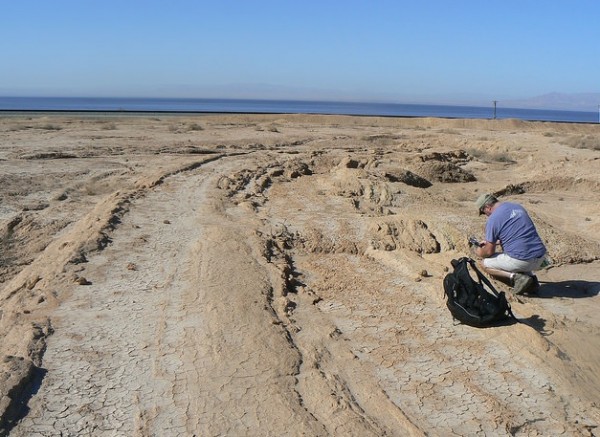By Ana Verayo, | October 08, 2016

Scripps geologist Neal Driscoll taking strike and dip measurements of the onshore sediment layers along the eastern edge of the Salton Sea.
Scientists are alarmed by the discovery of a new earthquake fault line in southern California that is also parallel to the San Andreas fault line.
This new fault line is located in the Salton Sea, which is a shallow sea inland in the western region of San Andreas fault line. Scientists call this the Salton Trough Fault.
Like Us on Facebook
Researchers found no records of any earthquakes occurring in the region that was linked to or caused by this fault line. Scientists have suggested that this new fault line could help "absorb" some stress from the San Andreas fault.
According to the Scripps Institution of Oceanography, this region is likely to face an earthquake soon as it has not yet seen a rupture in the last 300 years.
According to the co-author of the study and seismologist Graham Kent of the University of Nevada, the extended time since the last earthquake in the southern San Andreas is baffling to the earth sciences community.
Kent explained that based on deformation patterns, this new fault line apparently carries the burden of the strain from the larger San Andreas system. Since there is no record of past earthquakes, it is difficult to determine if this fault interacts with the southern San Andreas fault at depth.
Geological models of this earthquake-prone region would need to be changed due to this discovery especially to accurately predict potential earthquakes. According to the Scripps Institution of Oceanography, there has been a swarm of smaller earthquakes, around 200 of them in the Salton Sea. However, they are not connected to the new fault line.
According to the lead author of the study, Valerie Sahakian of the U.S. Geological Survey, it is crucial to correctly identify and locate fault lines before earthquakes happen to assess seismic hazard and reduce risk in a tectonically active region.
This new study has been published in the journal Bulletin of the Seismological Society of America.
-
Use of Coronavirus Pandemic Drones Raises Privacy Concerns: Drones Spread Fear, Local Officials Say

-
Coronavirus Hampers The Delivery Of Lockheed Martin F-35 Stealth Fighters For 2020

-
Instagram Speeds Up Plans to Add Account Memorialization Feature Due to COVID-19 Deaths

-
NASA: Perseverance Plans to Bring 'Mars Rock' to Earth in 2031

-
600 Dead And 3,000 In The Hospital as Iranians Believed Drinking High-Concentrations of Alcohol Can Cure The Coronavirus

-
600 Dead And 3,000 In The Hospital as Iranians Believed Drinking High-Concentrations of Alcohol Can Cure The Coronavirus

-
COVID-19: Doctors, Nurses Use Virtual Reality to Learn New Skills in Treating Coronavirus Patients







